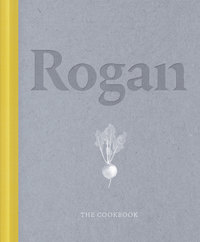
Полная версия
Rogan
These amazing shoots and herbs can be simply dressed in a light vinaigrette and served up having only been growing in the ground half an hour before. You can’t beat that freshness, that flavour, that message.
The success of our restaurants in Cartmel and London is the result of team effort. The land in the Lake District is called Our Farm because everyone who works with me has a stake in it. It is a vital cog in the business; every member of the team – whether in the kitchens or front of house – must spend one month on the land before they can work in the restaurant. Most chefs who join us have little or no experience with growing, and they can be a little overwhelmed at the sight of the rows and rows of beds and polytunnels, but once they’ve had this hands-on experience with the ingredients they have optimum respect for them and understand completely what they are working with. There’s no set pattern to what we grow, and this is reflected in our menu, so the chefs need this knowledge to be able to think on their feet and be able to combine flavours quickly and effectively. You can go up to the farm in the morning and then later in the afternoon and in that time a bunch of flowers will have opened up, ready to use. It is that violently seasonal – you have to be there four or five times a day before you can make a final decision because stuff just appears from nowhere, and to use it at its freshest you have to be there, on site, ready to pick it. You need to know every single millimetre of the land to know what is going on – and to be able to realise its potential. I’ll admit that at times this might seem a real pain to the chefs, and undeniably it means more work, but it is such a beautiful and simple concept.
Having the input from the chefs is also crucial because it means we can grow according to how they want to use the ingredients, cultivating leaves to the perfect size, nurturing live shoots in trays that can be delivered to the restaurant still in their soil ready to be snipped fresh for each plate. This is where growing our own is truly invaluable; because we mostly use micro veg – such as baby leaves, pencil leeks and tiny sweet radishes – we have the opportunity to produce bespoke ingredients for maximum flavour and texture.
We use vegetables at micro size not just because of the way they look on the plate, but also because at this point in their growth they are very small, delicate, perfectly textured and at their flavoursome peak.
As we grow our crops slowly, it is really important to use every corner of the site. The polytunnels and beds at Our Farm are hard-working; from spring through to early autumn every available inch of space is crammed with seedlings or plants – we even have pallets hanging from the tunnels’ struts in order to maximise growing space. These tunnels allow us to extend our growing season in a more natural way, to get a head start in spring and protect the plants from the British weather. If we need extra heat in the winter, we use the traditional method of using hot compost heaps to keep the roots of plants warm. In addition, we will place cloches, cold frames and hot beds around the site to keep the more tender plants warm in frosty conditions, and we have areas which are left untilled, to encourage the growth of edible wild plants, which we also harvest. The orchard beyond the beds is carefully planted not only to provide fruit, but to act as a natural windbreak against the wind that sometimes races through the valley.
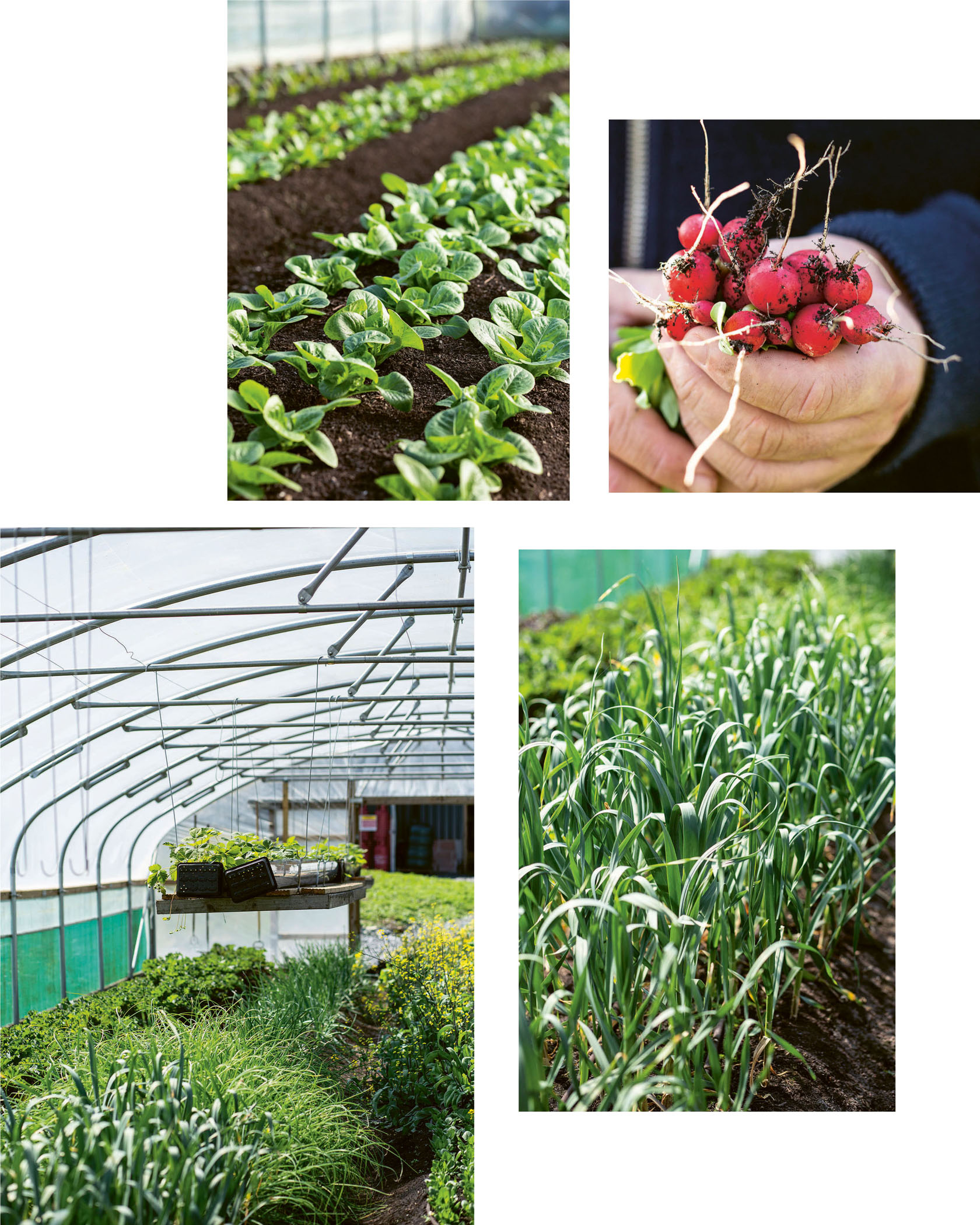
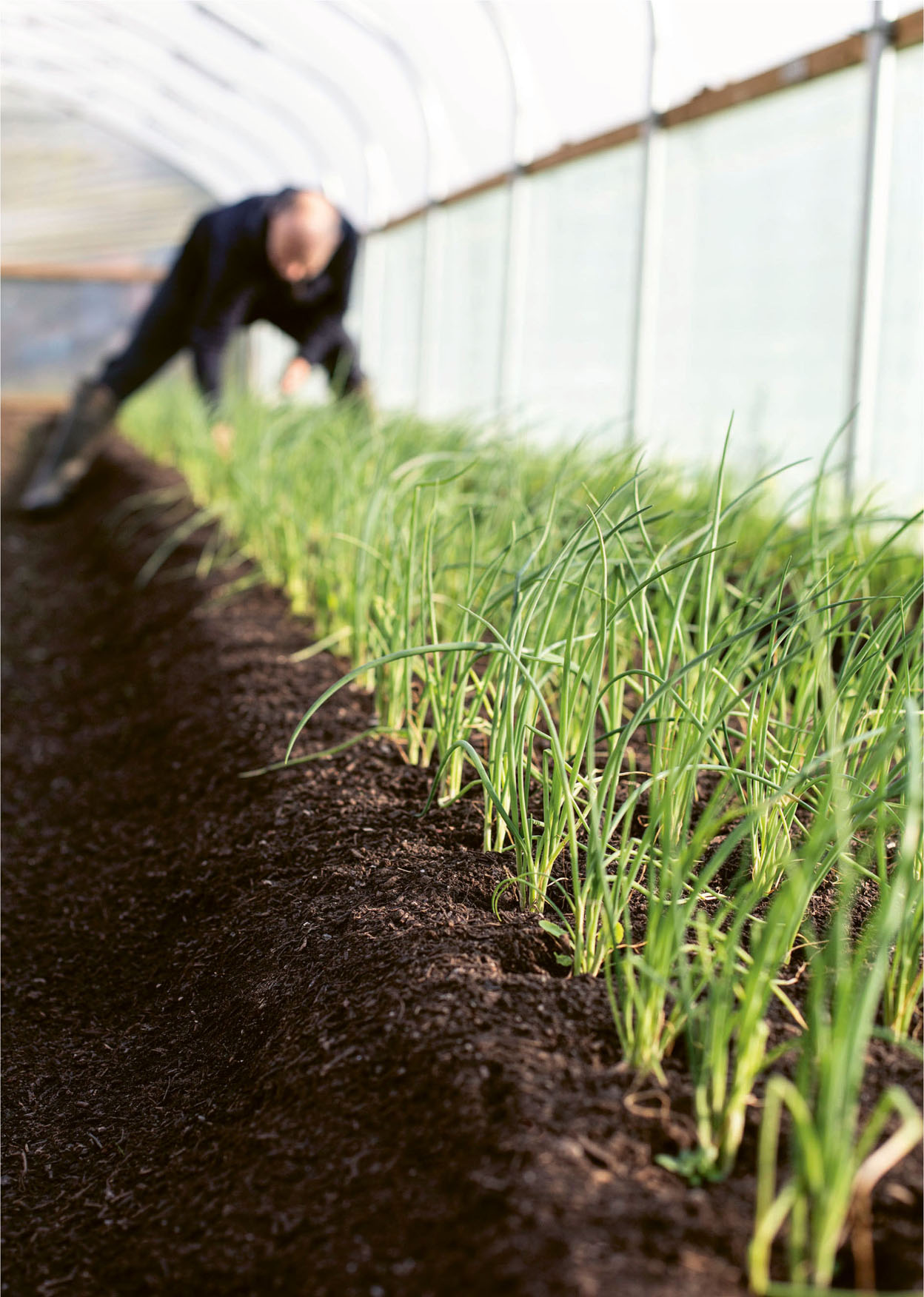
Spring and summer are our key growing periods, when we need to get cracking to produce as much as possible. Often when we get to August we have so much stuff we can’t get it all on the menu, there’s no space for it all. Winter is the only time when the soil is visible and we can at last draw breath, after a long year the last of the crops are harvested in autumn and stored to supply the restaurant through the winter. This is when we go back to our roots, embracing good old-fashioned preserving techniques.
All the traditional methods are employed to prevent wastage from our summer excesses – pickling, drying, fermenting, smoking, freezing, clamping (storing root vegetables in boxes filled with sand). Many of these processes even enhance the flavours of our ingredients; clamping vegetables encourages the carbohydrates to turn to sugar, creating a tastier, sweeter veg, while pickling and preserving allows us to add other flavourings and produce a whole different taste.
Our crops work hard for us – we study each plant at every stage of its growth, discovering new ways of using different parts of even the simplest varieties. When you’ve taken all that time to grow and nurture a plant you want to use every part of it. What’s left over and can’t be used gets composted – along with vegetable waste, animal manure, charcoal from the wood-burning oven. What we take out of the land we must put back, in order to maintain our mutually beneficial and respectful relationship with it.
Here again we can control what goes back into our soil, as we know that we are not introducing any chemicals into our compost and therefore the earth, so we can ensure it is healthy.
To me, this sums up so much of what we are trying to achieve in Cartmel. Experimentation is so much a part of what we do in the restaurants and the test kitchen; we are constantly trying to innovate and push the boundaries of what we can achieve, using all our natural resources to create new dishes and combinations.
In the sixteen years that we having been growing and cooking in Cartmel, we have made improvements year on year, learning from every mistake and every success. Weather and pests permitting, we now know what grows well, what doesn’t, and how we can get the best from what we are growing. But that doesn’t mean we’re going to stop there; the size of the farm has tripled since we first started and we now have chickens, pigs, sheep and cattle grazing the land around the tunnels and in the orchard, to produce a closed system where the animal waste is returned to the land, completing the circle of nature. This year we have our bees to provide honey and bee pollen – not to mention the benefits to our plants to have pollinators on site and doing our bit to help a dwindling bee population in this country.
For us, growing and rearing our own means being responsible for our levels of consumption – using what we have and not demanding more – and making best use of our natural resources.
We are proud of the unique way in which we stock our restaurants, and we are delighted to be at the forefront of a movement where chefs either produce their own ingredients or seek out local farmers to do it for them, with an awareness of the provenance of the food they are serving and a passion for their ingredients.
In the spirit of spreading the message and sharing our passion, this book was born. This isn’t a L’Enclume cookbook; you won’t find in these pages the recipes for some of the more complex dishes that we serve there, but these are variations of many favourites from our menu that have the essence of the flavours of our food. It isn’t an everyday cookbook, the recipes here are perhaps best used for inspiration and ideas for trying out new and exciting combinations, flavours and ingredients.
Of course, my cooking tends to use some more unusual ingredients or varieties because I’m lucky enough to be able to grow, source or forage for them in my local area. I know that some of these are hard to find for many, particularly if you are based in a city, so the recipes here mostly include ingredients that you can get hold of without too much trouble. Not everyone has access to woodlands on the doorstep for foraging in, coastal fish markets or 12 acres of land, I know, but we do all have access to good local markets and suppliers where we can buy organic fruit and vegetables, or meat, poultry or fish, knowing its provenance, and even local cheeses.
My journey from Southampton to Cartmel has been a long, and at times agonising one, but I would do it all again. For me, and the chefs who work with me, the idea of seasonality and fresh ingredients isn’t a gimmick, it’s our passion, it underlies everything we do. I am fortunate to have a restaurant and a team who have helped me to achieve great accolades in the culinary world, but I would cheerfully sacrifice any of these to uphold my principles about food production and the environment. It matters. It is our responsibility to future generations to nurture what we have now, and to leave them that legacy.
With this book I hope to share with you another way to eat – our way to eat – which will inspire you to demand more from your food. Think seasonal, think local, think organic, and if all else fails, think about the origins of your ingredients.

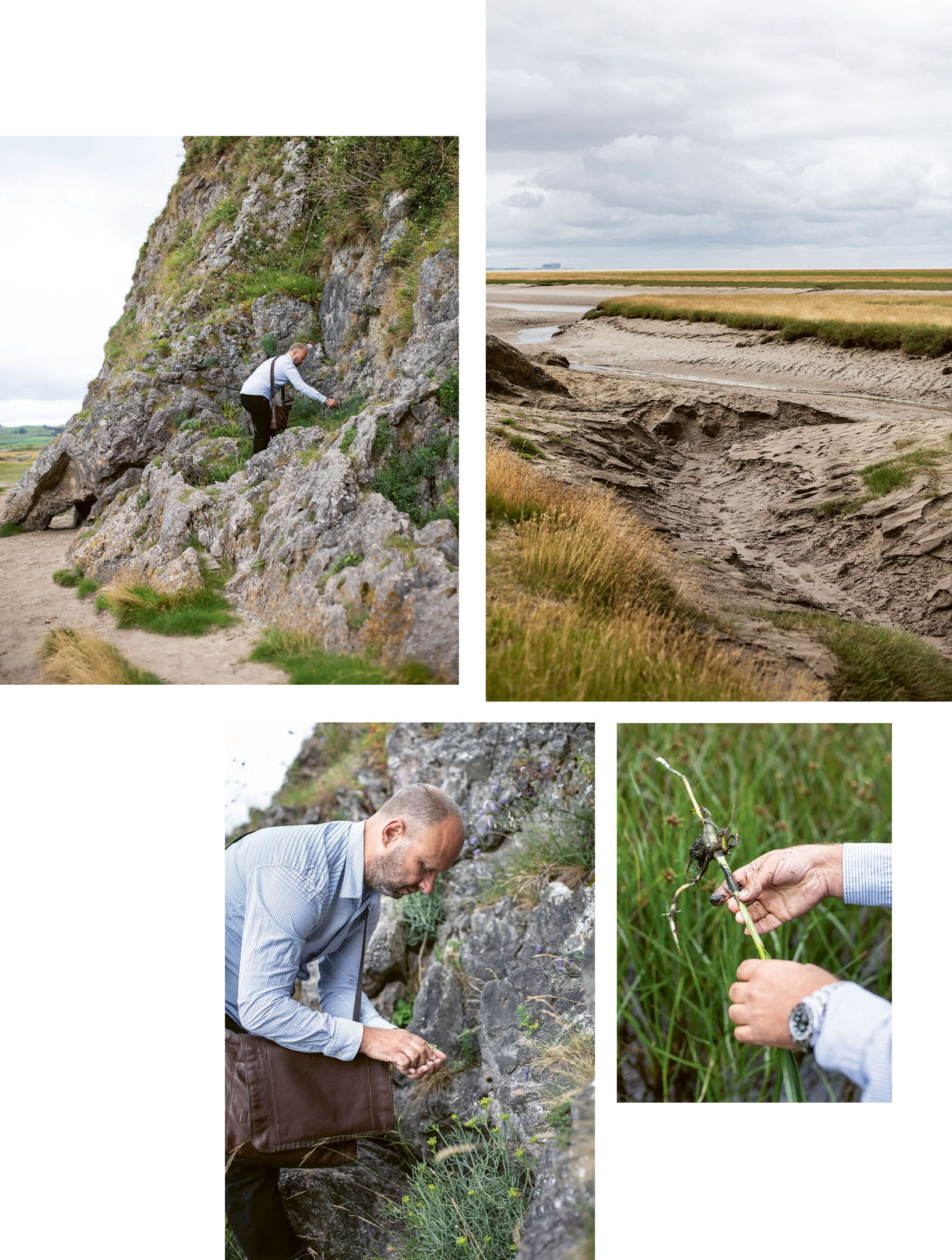

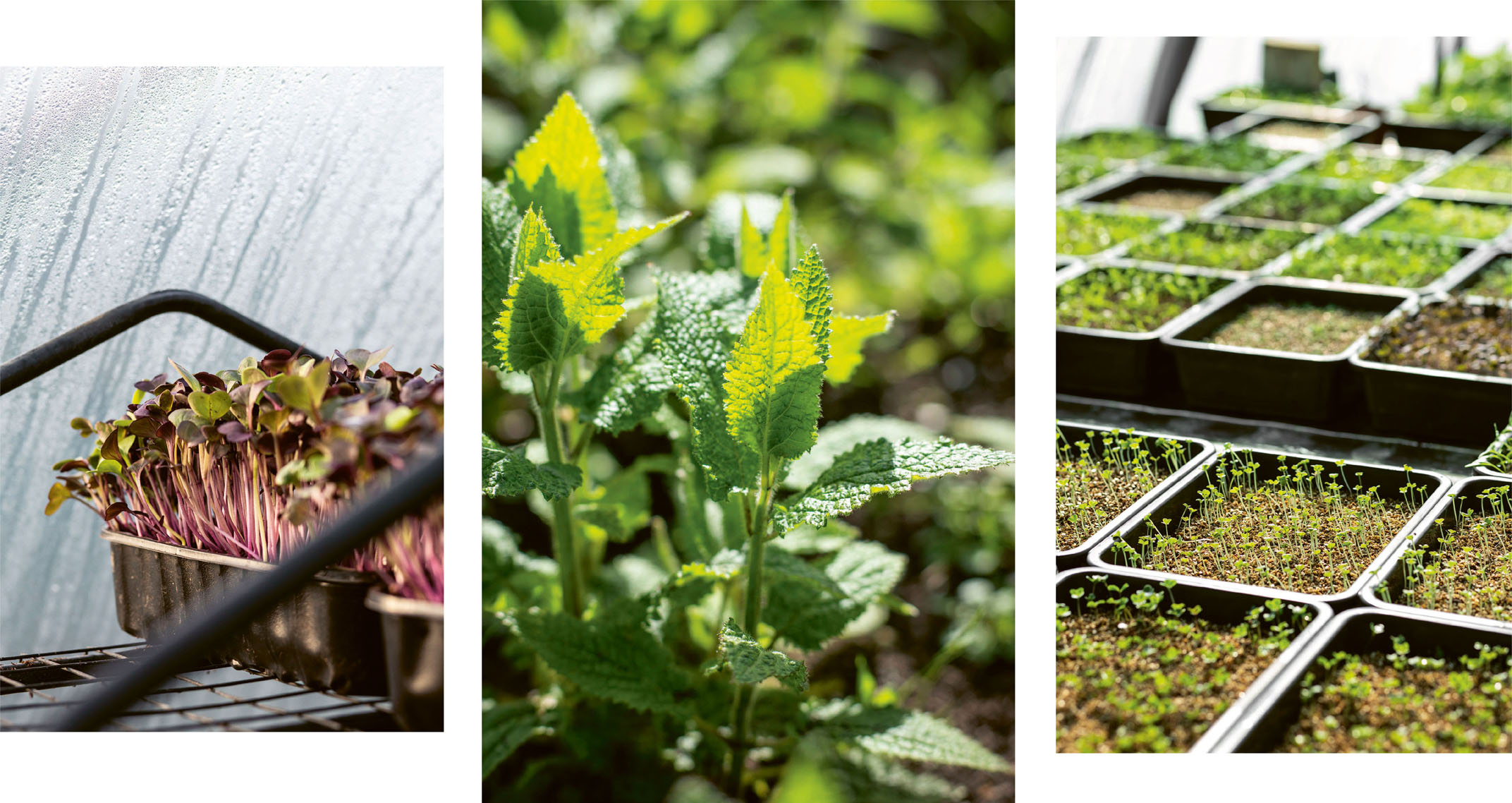
AYNESOME VEGETABLE INFUSION
Simply created as a celebration of all the flavoursome and delicious herbs and baby vegetables that we produce, this is a showcase for the produce from Our Farm, demonstrating exactly what we are all about, so it seemed only right to call this dish after the land where we grow – Aynesome.
SERVES 4, AS A STARTER
Vegetable broth
3 large onions, halved
6 red peppers, halved and deseeded
6 plum tomatoes, halved
2 sprigs of rosemary
2 bay leaves
2 sprigs of thyme
tapioca flour, for thickening
Aynesome vegetables
a few sprigs of bronze fennel tops
6 mixed colour cherry tomatoes, peeled (see here) and halved
4 baby pigeon cabbage leaves
2 courgette flowers, halved
2 baby turnips, halved
5mm-thick slice of kohlrabi, cut into 4 small discs using an apple corer
4 tiny baby radishes
32 broad beans, shelled
2 baby courgettes, 1 green, 1 yellow, each cut into 8
8 cooked simane onion petals (see here)
Thai basil leaves and brassica flowers, to serve
To make the broth, preheat the oven to 200°C/180°C Fan/Gas Mark 6. Place the onions cut side down on a baking tray and bake for 40 minutes until golden. After 5 minutes, put the peppers, cut side down on another baking tray and bake in the oven for 30–35 minutes until soft and starting to char, then add the tomatoes on another baking tray for the last 20 minutes of cooking. If the onions or peppers are beginning to brown too much, move them to a lower shelf or cover them with foil to avoid the stock becoming too dark.
Once cooked, put the vegetables into separate large, heavy-based saucepans and add 2 litres of water to each, adding the rosemary to the tomatoes, bay leaves to the peppers and thyme to the onions. Bring the pans to the boil over a medium heat, then cover with lids, turn the heat down as low as possible and cook for a further hour. Strain each liquid through a fine sieve into a measuring jug, making a note of how much stock you have – aim for 1 litre per pan – then stir them together in a large, clean saucepan.
For every 500ml of vegetable broth, blend 15g tapioca flour and 30ml water to a paste. Add to the warm liquid and whisk over a low heat for 5–10 minutes until it has thickened to a broth consistency (do not let it boil).
While the stock is thickening, arrange the Aynesome vegetables evenly into four bowls and sprinkle over some Thai basil leaves and brassica flowers. Pour over the hot thickened broth and serve immediately.
NOTE: This recipe yields around 1 litre of each broth, which is more than you need. Keep the leftover broth in the fridge for up to a week.
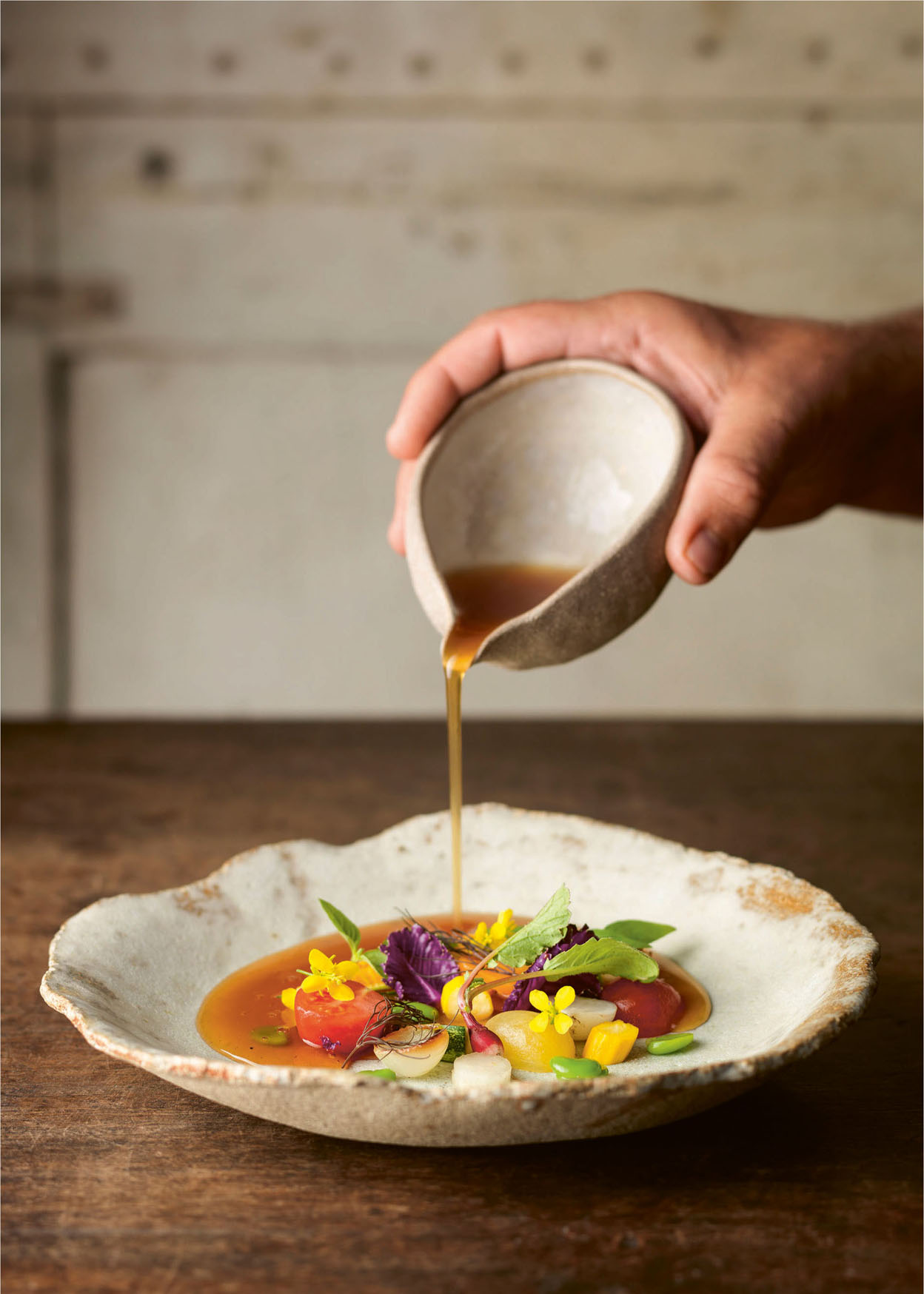
GRILLED COURGETTES AND QUAILS’ EGGS WITH MARJORAM BUTTER
If you grow your own courgettes, use a few different-coloured varieties for maximum visual effect. We use whatever we have growing, but particular favourites are green Passandra F1 and yellow Easy Pick Gold. (This dish is a great way to use up a glut, too!) The grilled courgettes are served with butter sauce flecked with marjoram, which adds a sweet spiciness. Add this right at the end, though, as these subtle flavours can be lost during cooking. The soft-boiled quails’ eggs from our birds add a little extravagant luxury here.
SERVES 4, AS A STARTER
Grilled courgettes
selection of mixed-size different-coloured courgettes, such as Partner, Passandra, Alena F1
2 tbsp sunflower oil
Courgette purée
75g unsalted butter
300g large green courgettes, thinly sliced
100ml double cream
Marjoram butter sauce
2 tbsp sunflower oil
140g white onion, finely diced
50ml white wine vinegar
150ml white wine
10g marjoram leaves
160ml double cream
300g unsalted butter, cut into small pieces
Quails’ eggs
50ml white wine vinegar
12 quails’ eggs
salt, for seasoning
To make the purée, melt the butter in a large, heavy-based saucepan over a medium–high heat, then add the courgettes and sweat them for 5–6 minutes until tender and soft. Add the cream and cook for about 2 minutes to reduce the liquid, until the cream is almost split. Transfer to a blender and blitz until smooth. Season with salt and leave to one side.
Preheat a barbecue or grill to high.
To make the marjoram butter sauce, warm a large saucepan over a medium heat, add the oil and sweat the onion, stirring regularly, for 5–7 minutes until translucent. Deglaze the pan with the vinegar and wine, add half the marjoram and cook for 3–4 minutes until reduced to a syrup. Pass the syrup through a fine sieve into a medium saucepan, set the pan over a medium heat and add the cream, stirring well. Bring to the boil then reduce to a simmer. Gradually add the butter pieces, whisking constantly and adding more when the previous piece has melted and is incorporated into the sauce. Remove from the heat and season with salt.
Halve the courgettes, cutting any larger bits into chunks, coat in the oil and season with a pinch of salt. Cook on the barbecue or grill until charred and tender.
To cook the quails’ eggs, pour 45ml of the white wine vinegar into a wide bowl and carefully crack in all of the eggs, slightly spaced apart. Allow the eggs to sit in the vinegar for 2 minutes. Meanwhile, bring a medium saucepan of water to the boil and add the remaining vinegar. Turn down the heat and reduce to a simmer. Swiftly but carefully remove the eggs from the vinegar one at a time with a slotted spoon, transfer straight into the simmering water and cook all the eggs together for 1 minute 20 seconds. Remove and season with salt. They will look like little hard-boiled eggs because the vinegar sets the white around the yolk.
Spoon the courgette purée on to plates, then divide the grilled courgettes among the plates, distributing the shapes and sizes evenly. Finish the sauce with the remaining chopped marjoram and drizzle over. Carefully halve the eggs and add to each plate.
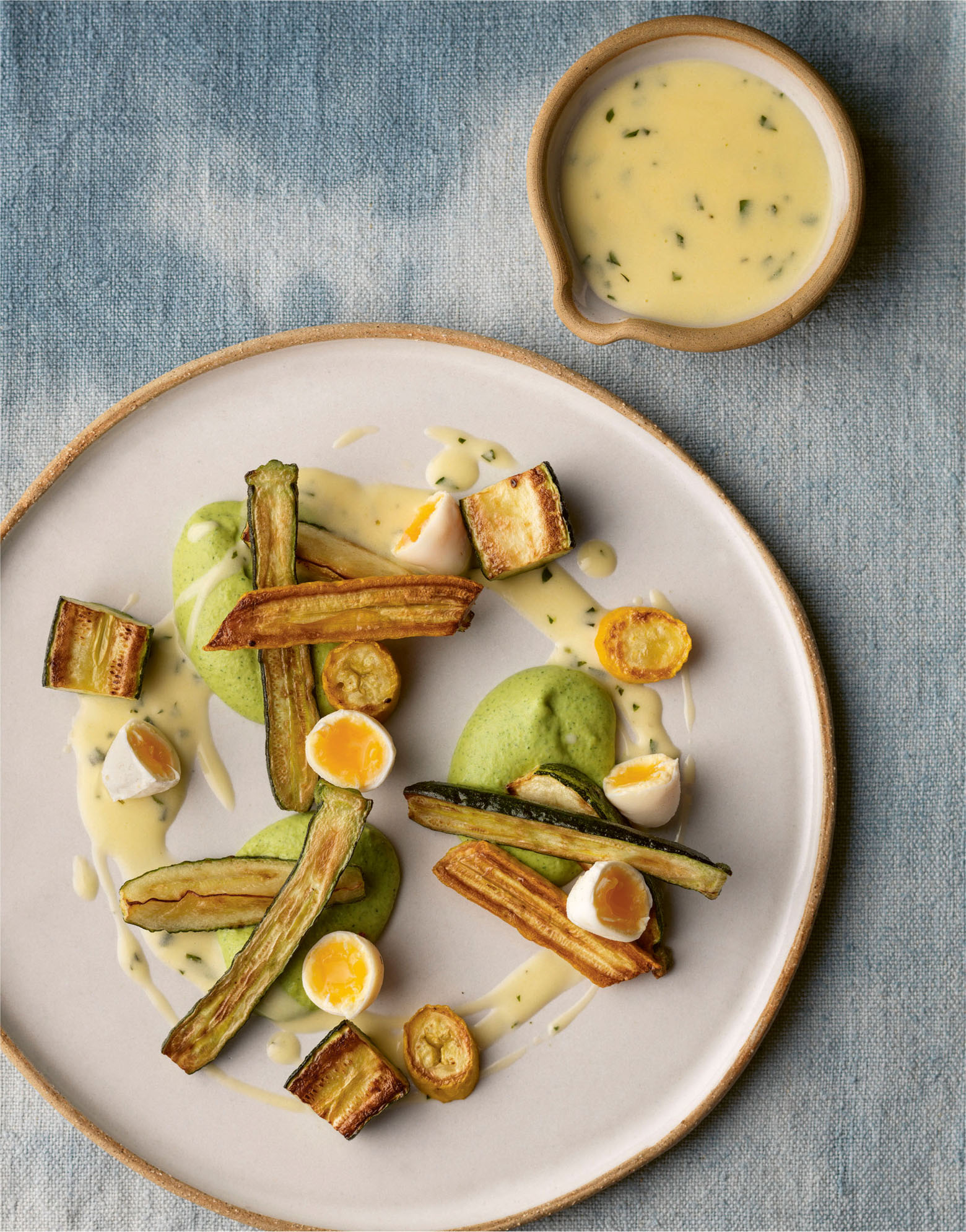
HERITAGE POTATOES WITH LOVAGE AND ONION ASH
We grow heritage potatoes at Our Farm, because they have a deeper flavour than most ordinary new potatoes, but a good organic baby potato will do just as well here. The maltodextrin for the onions is optional; it adds a white speckling to the black powder that, visually, gives it more depth and the appearance of real ash, but you can leave it out if you can’t get hold of it. Lovage is a staple in my mind and its pungent, musky overtones of anise, lemon and mint are perfect for livening up potato dishes – but be warned, a little goes a long way!
SERVES 6–8, AS A SIDE
Onion ash
1kg large white onions
50g maltodextrin (optional)
Confit potatoes
500g heritage baby potatoes, such as baby red King Edwards
300ml rapeseed oil
10g salt
2 bay leaves
1 tsp white peppercorns
4 garlic cloves, crushed
Caramelised shallot purée
350g shallots, sliced
1 tbsp sunflower oil
50g unsalted butter
70ml whole milk
salt, for seasoning
Lovage emulsion
100g flat-leaf parsley leaves
100g lovage leaves
300ml sunflower oil
2 soft-boiled eggs (cooked for 4 minutes)
Preheat the oven to 200°C/180°C Fan/Gas Mark 6. To make the onion ash, cut the unpeeled onions in half and place on a baking sheet lined with baking parchment. Bake for 1½ hours until black. Leaving the onions in the oven, reduce the heat to 110°C/90°C Fan/Gas Mark ¼ and dry them out for about 3 hours.
Meanwhile, confit the potatoes. Put all the ingredients in a medium, heavy-based saucepan over a low heat and cook slowly for about 2 hours until the potatoes are tender.
Meanwhile, make the purée. Cook the shallots in the oil and butter in a large, heavy-based saucepan over a low heat for 35–40 minutes, stirring regularly. When the shallots have turned a deep golden colour, strain them, pouring off and reserving the ‘onion oil’. Blitz the drained shallots with the milk in a blender until smooth. Pass through a fine sieve, season with salt and leave to one side.
Blend the blackened dried onions and maltodextrin, if using, into a powder, then stir in the ‘onion oil’ to make the ash a little clumpy. Put to one side.
To make the emulsion, bring a large saucepan of water to the boil and blanch the parsley and lovage leaves for 1 minute. Scoop them out with a slotted spoon and refresh in a bowl of iced water. Drain, squeeze out the excess water and blitz the herbs with the oil in a blender until smooth. Pass the herb oil through a muslin-lined sieve. Blitz the soft-boiled eggs in a clean blender on medium speed, adding the lovage oil slowly until the emulsion has a mayonnaise consistency; season with salt.
Spoon dots of shallot purée on to a serving dish and sit the drained warm potatoes on top. Spoon a small amount of lovage emulsion on each potato and scatter over the onion ash.
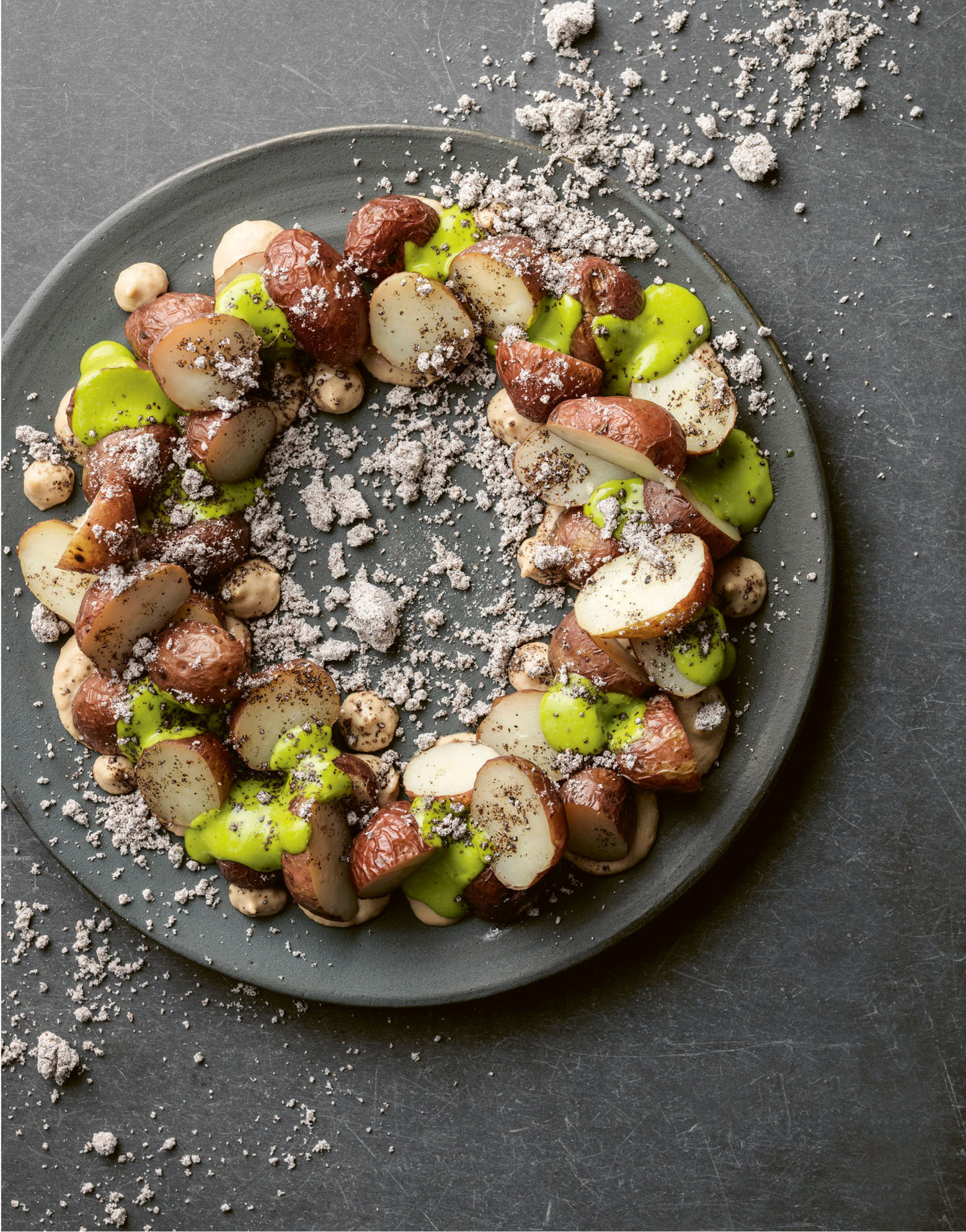
BABY POTATOES WITH OX-EYE DAISY SPREAD AND CULTURED CREAM
In June you will see ox-eye daisies everywhere – along roadside verges as well as in domestic gardens. These yellow-centred white flowers grow like weeds, so there’s no problem with foraging a few flowerheads for this dish. The flower buds are pleasingly aromatic and perfect for flavouring savoury vegetable dishes. Cultured cream is fermented crème fraîche, so including this helps you to stock up on good bacteria in your digestive system. The cultures take 4 days to activate, so you need to plan ahead, and make sure you use live culture crème fraîche to ensure proper fermentation.
SERVES 6, AS A STARTER
Cultured cream
250g double cream
40g crème fraîche
Ox-eye daisy spread
1 carrot, chopped
1 beetroot, chopped
1 onion, chopped
2 garlic cloves, chopped
50g unsalted butter
1 tbsp plain flour
2 handfuls of ox-eye daisy
1 handful of mugwort
1 tsp ground ginger
juice of 1 lemon
1 tbsp tomato purée
Baby potatoes
350g baby potatoes
1 tbsp salt
Maldon sea salt and freshly ground black pepper, for seasoning
pea shoots, borage flowers, rapeseed oil, to serve
To start the cultured cream, warm the cream in a small, heavy-based saucepan over a low heat until it reaches 34°C (check with a thermometer). When the temperature is reached, remove the pan from the heat and stir in the crème fraîche. Transfer the mixture to an airtight container and leave for 3 days at room temperature, then transfer to the fridge for 1 day.
Heat a large, heavy-based saucepan over a medium heat. Cook the carrot, beetroot, onion and garlic in the pan with the butter and a pinch of salt, stirring regularly, for 10–12 minutes until tender. Sprinkle in the flour, stir it into the vegetables and cook for a further minute. Add the rest of the ingredients, along with 20ml water, and cook for a further 5 minutes, stirring at regular intervals. When almost all the liquid in the mixture has evaporated, remove from the heat and blitz with a hand-held blender until smooth. Pass through a fine sieve. Keep warm.
Put the baby potatoes in a medium saucepan with the salt and cover with cold water. Cook over a medium heat for 10–12 minutes, or until tender, then drain.
Smear ox-eye daisy spread on each plate, add dollops of cultured cream and set the warm potatoes on top. Season with Maldon sea salt and freshly ground black pepper, sprinkle with pea shoots and borage flowers and drizzle with rapeseed oil.
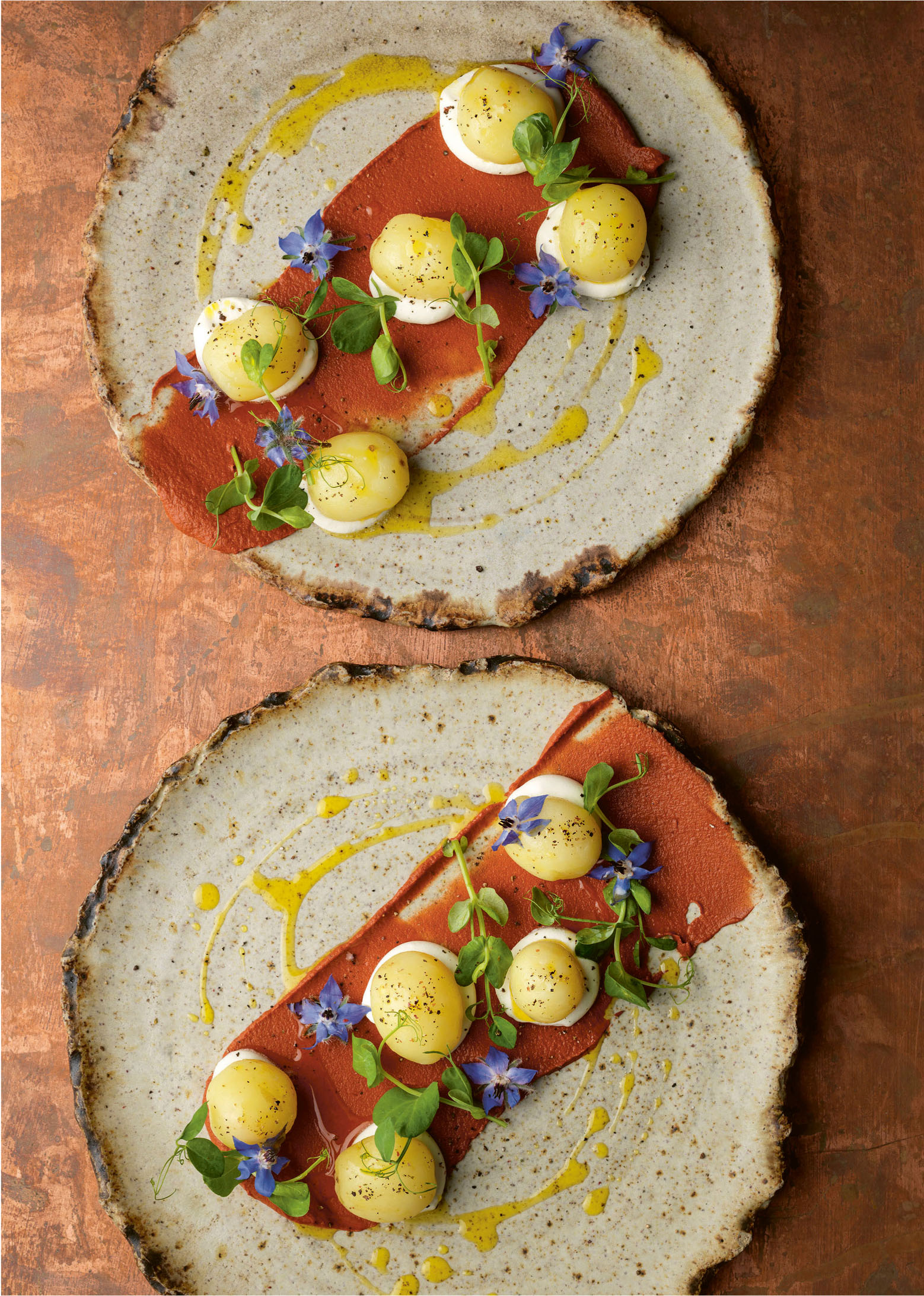
DOCK PUDDING WITH RAMSON EMULSION
In Cumbria this is traditionally eaten at Easter and is better known as Lent pudding. It is eaten at this time of year because supposedly this combination of fresh spring herbs cleanses the system of the fats eaten during the winter. The flavours are fresh and aromatic; acidic dock and herby, vegetal nettles are accentuated by the garlicky hit from the ramson emulsion. This recipe is a forager’s dream; nettle, dandelion and dock leaves grow across the country throughout most of the year, but ramsons, also known as wild garlic, have a short season in late spring, so make plenty of emulsion then, as we do, when ramsons are available and freeze it for use over the next few months.
SERVES 4, AS A STARTER
Dock pudding
200g pearl barley
6 Savoy cabbage leaves
10g nettle leaves
5g dandelion leaves
5g dock leaves
2 tbsp sunflower oil
½ onion, diced
1 leek, thinly sliced
75g porridge oats
2 hard-boiled eggs (cooked for 8 minutes)
Dock pudding crumb
250g panko breadcrumbs
5g dock leaves, dried
5g ramson leaves, dried
4 eggs, beaten
200g plain flour
Ramson emulsion
100g flat-leaf parsley leaves
20g ramson leaves
200ml sunflower oil
2 soft-boiled eggs (cooked for 4 minutes)
salt, for seasoning
vegetable oil, for deep-frying
First, make the dock pudding. Cook the pearl barley in 1 litre of water in a medium saucepan over a medium heat for 25 minutes until soft and tender. When cooked, rinse under cold running water to cool, then leave to drain.
Bring a large pan of salted water to the boil and blanch the cabbage leaves for 2 minutes, then remove them with a slotted spoon and refresh them in a bowl of iced water. Drain and squeeze out the excess water. Repeat with the nettle, dandelion and dock leaves, blanching them for 1 minute each. Slice all the blanched leaves thinly and leave to one side.
Warm the oil in a large, heavy-based saucepan over a medium heat, add the onion and leek and sweat for 3–5 minutes, or until translucent. Add the cooked pearl barley, blanched leaves and porridge oats, stir well and cook for a further 2 minutes. Remove from the heat. Grate the hard-boiled eggs and add them to the mixture. Taste, season with salt and leave to one side to cool, then roll the mixture into golf ball-sized balls and chill.




